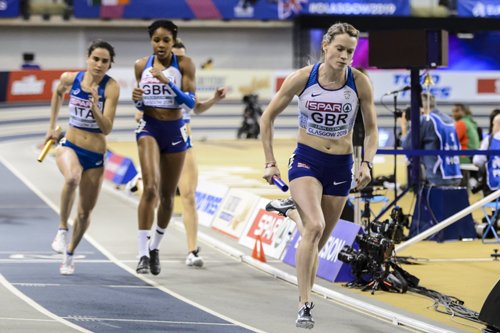Eilidh Doyle has retired. One of the most prolific and enduring European relay runners, as well as 400m flat and 400m hurdle racers, has hung up her spikes. Stuart Weir, our European correspondent, has written a series of columns on this fine athlete. This column is on her experiences in the relays, and there is lot to learn for both coaches and athletes from this column.
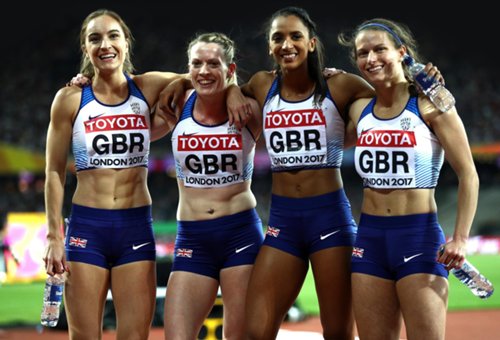 British women’s 4x 400m team, silver medal, London 2017, photo by British Athletics
British women’s 4x 400m team, silver medal, London 2017, photo by British Athletics
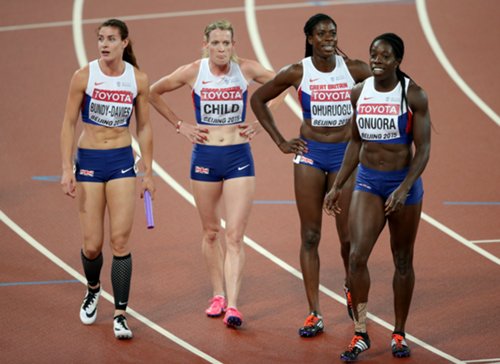 British Relay 4x400m, Beijing 2015, bronze medal, photo by British Athletics
British Relay 4x400m, Beijing 2015, bronze medal, photo by British Athletics
Eilidh Doyle takes off, 2019 European Indoors, British 4x 400m took silver, photo by European Athletics
The relay runner
Eilidh Doyle is a serial relay medal winner – 12 in all in championships. In this piece she shares some of the secrets of the 4 by 400 relay.
4 by 400 Relay medals
Olympics
2016 – bronze
World Championships
2013 – silver
2015 – bronze
2017 – silver
World Relays
2015 – Bronze
World Indoors
2014 – bronze
European Championships
2014 – bronze
2016 – gold
2018 – bronze
European Indoors
2013 – gold
2017 – silver
2019 – silver
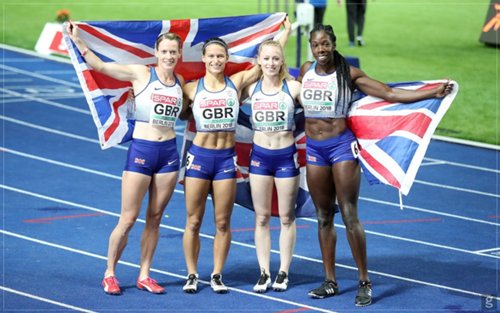 European outdoors, Berlin 2018, British 4x400m (Eilidh is on left), photo by European Athletics
European outdoors, Berlin 2018, British 4x400m (Eilidh is on left), photo by European Athletics
Is the first leg your favourite?
Yes. Because in the first leg you know what is going to happen. I can have a race plan in my head and execute it because I know I’m going to run my leg in my lane and I know pretty much what I can do on the first leg. Mentally, it is the one that’s the easiest to prepare for because you just execute your own race in the same way as I would in 400 hurdles or 400 flat. Saying that, I know lots of people don’t like the first leg.
I’m not fast. A lot of the girls I race against would beat me over 200. I’m more of a 4/8 runner with strength and endurance and that’s why I think the first leg suited me as I have a little bit of extra endurance to hang on. Don’t get me wrong, there have been times when I was just dying to get the baton to the next runner.
One of the reasons I am doing the relay is to make me get out of my comfort zone. Here it is about being more assertive, more aggressive and getting more competitive experience. I have done some relays when I have done 3rd leg and so on but I have been fairly lucky in relays, not having too much going on around me so this will take me out of my comfort zone, having to work a bit harder and it will give me the experience for the legs I might need to do in the relays as well.
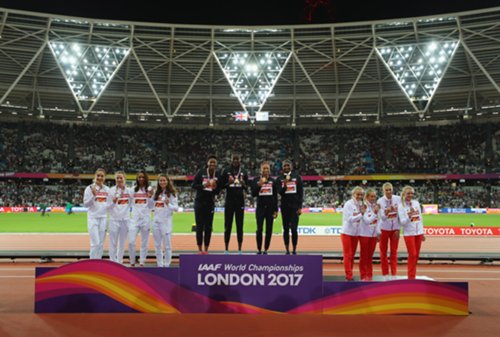 London 2017, 4x400m women’s relay awards, photo by World Athletics (USA gold, British, silver, Poland, bronze)
London 2017, 4x400m women’s relay awards, photo by World Athletics (USA gold, British, silver, Poland, bronze)
Did relay running come naturally to you?
I would say that I’ve just learned how to run it. I owe a lot of that to Lloyd Cowan. Lloyd used to give me real proper tips going into a relay race. Often relay coaches would just say something like ‘go and do what you do’ or ‘make sure you attack the race’ but Lloyd would often break it down for me. My first experience of it was going to the Penn relays in 2013. It was myself, Christine Ohuruogu, Shana Cox and Perri Shakes-Drayton, the team that won in Gothenburg and we were so close to beating the Americans and that was really because of the tips that Lloyd was giving me. I really learned the craft of the race – the positioning of where I should be. I think that’s why I was so consistent and solid on it because I knew how to run it.
Are indoor relays different?.
Yes. indoor relays are very tactical and very dependent on lane draw. You really want one of the outside lanes for the first leg because you really want to be in amongst it. It’s a lot more tactical than the outdoor 4 by 400. Outdoors, I think whoever has the fastest athletes will win. Indoors you can win without having the fastest athletes by getting the order right and getting your tactics right.
What do you like about relays?
The team aspect. You have a bond with the others and you don’t want to let the others down. I want to win a medal in the relay but I want the others to win a medal as well and that is added pressure.
In an individual race, yes you have nerves, but you can control it and it’s all on you and if you don’t run well it is you who are affected. But in the relay you don’t want to be the one who runs badly so that the others don’t get a medal and that is where the nerves come from.
I have run a lot of relays with Christine Ohuruogu and she always gets us together before we go out and says: ‘We are a team, we are going to go onto the track together and whatever happens we leave the track together’. It is that last piece of reassurance to know we are a team and that we are all going to run our hearts out whatever happens. It is a nice calming feeling before you go out.
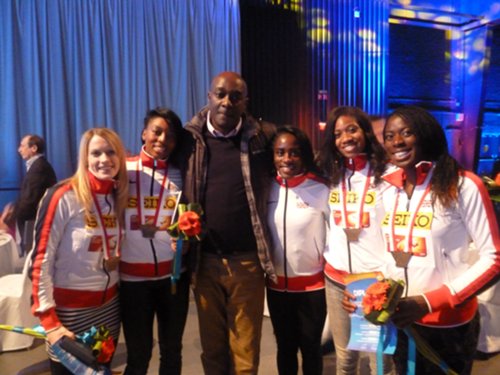 British 4 x 400m relay squad, Sopot Indoor 2014, photo by Eilidh Doyle
British 4 x 400m relay squad, Sopot Indoor 2014, photo by Eilidh Doyle
In 2016 you won an Olympic medal; was that special?
When I came off the track in Rio after the 400 hurdles final, I was disappointed and I was a bit gutted because I thought I don’t know what else I could have done – at the time it was an emotional response but afterwards I could be more logical about it. That was why it was so important in Rio to win a medal in the relay. I’d had such a great season in 2016 and I kind of felt that I deserved something from it. While the medal was for the relay I felt that my whole 2016 season was encompassed within that medal.
Author

Caitlin Chock set the then National High School 5k Record (15:52.88) in 2004 and went on to run professionally for Nike. A freelance writer, artist, and comedian in Los Angeles, you can see more of her work on her website, Instagram and Twitter.
View all posts

